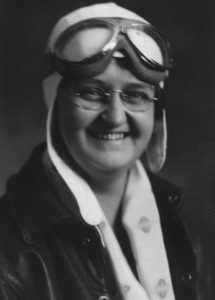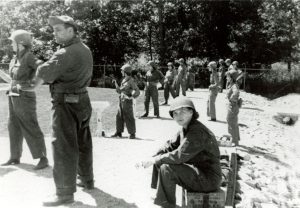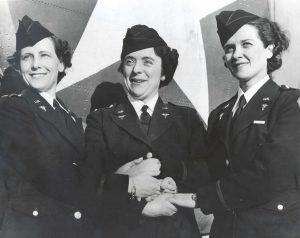Sixth in a Series of Seven Blogs about Drama in Nursing
Nurse Stereotypes in Movies
Naughty – M*A*S*H
If the battle axe nurse is the subversion of the doctor’s handmaiden, the naughty nurse is the subversion of the angel of mercy. She, too, has a military origin, for nurses were linked in the past with camp followers who serviced encamped soldier’s sexual needs. The naughty nurse’s mercy, should she choose to bestow it, is sexual or at least tauntingly suggestive, not benevolent. When others project naughtiness onto the nurse, the stereotype is that of sex object. Whereas the angel and the handmaiden are Mary figures, the naughty nurse and the battle axe are more like Eve, dangling the fig leaf of temptation or the clipboard before the eyes of doctors and patients alike. Because nursing involves intimate contact with bodily parts, it has been equated with sexual availability. Nursing leaders Claire Fagin and Donna Diers lament, “Thanks to the worst of this kind of thinking, nursing is a metaphor for sex. Having seen and touched the bodies of strangers, nurses are perceived as willing and able sexual partners. Knowing and experienced, they, unlike prostitutes, are thought to be safe – a quality suggested by the cleanliness of their white uniforms and professional aplomb.” 1
Media representations of nurses have capitalized on this stereotype. In their study of the extent to which professional nursing is associated with negative sexual imagery in Hollywood films from 1930 to 1980, Kalisch, Kalisch and Mary McHugh found that the stereotype was most prevalent in 1960s and 1970s comedies and horror films. Almost three quarters of the one hundred ninety-one films analyzed showed highly developed characterizations of or medium emphasis on the nurse as sex object. 2 Darbyshire and Gordon suggest that to sexualize women nurses metaphorically allows men, who are placed in a vulnerable, dependent position as hospital patients, to redress this power imbalance and regain control over the situation. 3 Male doctors who sexualize female nurses may themselves have power issues and expect subservience not only in professional matters but in sexual ones as well.
A classic example of the sexualized nurse is Major Margaret “Hot Lips” Houlihan in the 1970 film M*A*S*H, based on Richard Hooker’s book of the same title. Although released during the Vietnam War, the film depicts the staff of a Mobile Army Surgical Hospital during the Korean War. Hooker’s initial description of Houlihan sets her up as a sex object in the eyes of the three surgeons who are the focus of the film: Captains “Duke” Forrest, “Hawkey” Pierce, and “Trapper John” McIntyre:
It took a femme fatale, however, to restore peace, more or less, to the 4077th MASH. She was Major Margaret Houlihan, new Chief Nurse, and one June morning she emerged, not out of a scallop shell like Botticelli’s Venus, but out of a helicopter. She was tallish, willowish, blondish, fortyish. She had a nice figure. In fact, she was a nice-looking, forty-year-old female. 4
The major clearly was no battle axe. Or was she?
As soon as she arrived at the 4077th MASH, Major Houlihan observed both twelve-hour shifts in the operating tent. She was impressed with Major Burns’s day shift, for, in the film version, she considered him “not only a good technical surgeon, he is a good military surgeon,” but was less impressed with Hawkeye’s night shift. “I’ve also noticed that nurses and enlisted men address you as Hawkeye,” Houlihan says. “Well that kind of informality is inconsistent with maximum efficiency in a military organization.” Hawkeye is fed up with her military ways. “Oh, come off it, Major,” he replies and suggests that had the conversation gone differently, he might have invited her back to his tent and she might have come. “You really put me off. You’re what we call a Regular Army Clown.’”Or, in other words, the ridiculed battle axe. But the Major is projecting a mixed impression: She is pretty, and Hawkeye calls her “Gorgeous. You’re a sight for sore eyes” when she asks to join him at his table. But when he asks where she is from, her reply is off-putting: “Well, I like to think of the army as my home.” Nevertheless, Hawkeye’s veiled proposition suggests that he sees her also as a sex object. Houlihan’s reaction after Hawkeye has left the mess tent is to address its occupants: “I wonder how a degenerated person like that could have reached a position of responsibility in the Army Medical Corps?’ Dago Red, the priest, replies, ‘He was drafted.” 5
A nurse need be limited to one stereotype but can project different images depending on the situation and on the response she gets from her ‘audience’ to the impression she is trying to make. For instance, on duty Major Houlihan is viewed as a battle axe when in her chief nurse position but, like the other nurses, is a handmaiden to the surgeon when in the operating tent; off duty she is viewed as a sex object. This last stereotype is the focus of two scenes in the film. In one, male staff of the 4077th rig the shower tent to raise its flaps at the very moment that Houlihan is undressed and taking her turn. The three surgeons are among those sitting ringside to watch the ‘reveal’. Houlihan, after grabbing a bathrobe, is hysterical: “This isn’t a hospital,” she yells, “it’s an insane asylum!”
Houlihan likely was still livid from the first prank the surgeons pulled on her shortly after her arrival. Frank Burns, in charge of the day shift, was the ranking surgeon and second in command at the 4077th MASH. Superficially pious and God-fearing, he was a technically competent but morally inept surgeon who blamed others for his mistakes, placing him on the receiving end of the other surgeons’ ire. Houlihan, however, was quite impressed with Burns, whose military demeanor and gracious disposition contrasted sharply with the other surgeons’ unmilitary attitudes. The feeling must have been mutual, for not long after meeting, they are heard in Houlihan’s room vocalizing sexual pleasure that, unknown to them initially, is being broadcast live on the MASH public address loudspeakers from a microphone hidden under her cot for the entertainment of the 4077th. The tryst earned her the ‘Hot Lips’ appellation.
Captain Bridget “Knocko” McCarthy, who appears as a background character in the film, has a stronger presence in the book as the nurse second in command to Major Houlihan. Like her boss, she displays characteristics of more than one stereotype. Hooker writes:
The Duke ran ahead of the stretcher. In the OR he encountered, fortunately, the boss, chief, honcho, leader and head coach of the operating room nurses, Captain Bridget McCarthy of Boston, Massachusetts. …
Captain Bridget McCarthy was maybe thirty-five years old, five feet eight inches of solid maple, and she did not ordinarily tolerate much lip from the Swampmen [the three surgeons] or her immediate superior, Major Hot Lips Houlihan, either. This last endeared her to the Swampmen who did not call her ‘Knocko’ for nothing, for they knew she could take out any one of them in a head-on. More than anything, however, she was also a nurse who had come specifically to be a nurse, so when Duke gave orders with fire in his eye she asked no questions and said, ‘Yes, sir.” 6
McCarthy’s physical description suggests the battle axe stereotype, and her behavior in the operating room might suggest the handmaiden stereotype, but the overall impression is one of a respected professional nurse.
Yet when Brigadier General Hammond, head of the Army Medical Services, Seoul sector, visits the 4077th with his adjutant to speak with its commander and tells his adjutant to “check this place out – see what the nurses are like, huh?” he doesn’t necessarily mean professionally. Whatever may be the impression projected by the nurses of the 4077th in the M*A*S*H film, their male colleagues view them predominantly as the naughty stereotype and as sex objects, evident in the many scenes in which the surgeons voice sexual innuendos. The stereotype is more blatant when, over lunch in a scene from Hooker’s book, Hawkeye Pierce gives “a word on the nurses,” surgeon to surgeon, to Captain “Jeeter” Carroll, who is new to the 4077th. “They’re human, just like us,” he says. “Some of them do all of the time, some of them do some of the time, and observation over a period of many months convinces me that very few of them are queer.” Hawkeye then explains the two methods to “score” with a nurse – “One is the simple, staid, stateside, hackneyed, civilian approach where you devote all your spare time for a week. … The second method is quicker and statistically almost as sound” and involves talking to the nurse for a few minutes at a social situation, preferably over a drink, and then propositioning her. “The big plus of this method is that you either score fast or lose fast. And if you lose you can go on to the next blossom without further waste of time, effort and good booze.”. 7
Stereotypes can get in the way of nurses’ impression management as individuals and for nursing as a profession. But, as Darbyshire points out, it is not “particularly astute’ to think that the media, whether in print, on stage or onscreen, exists to depict nurses and their work ‘accurately … It is not nursing’s public relations machine.” 8
In their study of the changing image of the nurse in mass media entertainment through the early 1980s, Kalisch and Kalisch found five image types fundamentally coinciding with five successive time periods:
1854 – 1919 Angel of Mercy
1920 – 1929 Girl Friday
1930 – 1945 Heroine
1946 – 1965 Wife and Mother
1966 – 1982 Sex Object
The authors suggested that a sixth dominant image be added – that of Careerist, whom they define as a nurse who is ‘intelligent, logical, progressive, sophisticated, emphatic, and assertive’ – in an attempt to chart a better future image for nursing. 9 They note that while the media continued to portray nurses in four of the above images, the nurse as heroine was quietly forgotten.
To learn how the history of nursing was reflected on the opera stage, see Judith Barger, The Nurse in History and Opera: From Servant to Sister (Lexington Books, 2024).
Notes
- Claire Fagin and Donna Diers, “Nursing as Metaphor,” AJN 83 (9) (September 1983): 1362; originally appeared in New England Journal of Medicine 309 (2) 914 July 1983): 116–17.
- Beatrice J. Kalisch, Philip A. Kalisch and Mary L. McHugh, “The Nurse as a Sex Object in Motion Pictures, 1930 to 1980,” Research in Nursing and Health 5 (1982): 147–54.
- Darbyshire and Gordon, “Exploring Popular Images,” 80; Darbyshire, “Heroines, Hookers and Harridans,” 58.
- Richard Hooker [Hiester Richard Hornberger Jr], M*A*S*H (Mattituck, NY: Rivercity Press, 1968), 45. The original title was MASH: A Novel About Three Army Surgeons.
- M*A*S*H. [1970] Directed by Robert Altman, 1970. Produced by Ingo Preminger. Screenplay by Ring Lardner, Jr. Beverley Hills, CA: Twentieth-Century Fox Home Entertainment DVD, 2004.
- Hooker, MASH, 83.
- Hooker, MASH, 101–102.
- Darbyshire and Gordon, “Exploring Popular Images,” 83. See also Darbyshire, “Heroines, Hookers and Harridans,” 60.
- Kalisch and Kalisch, The Changing Image of the Nurse, xi, 8, 184. Girl Friday corresponds with handmaiden.



